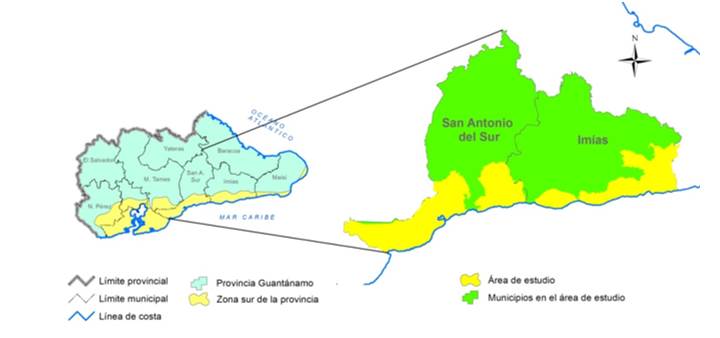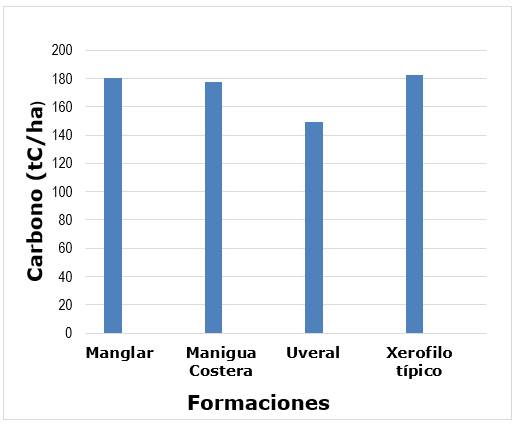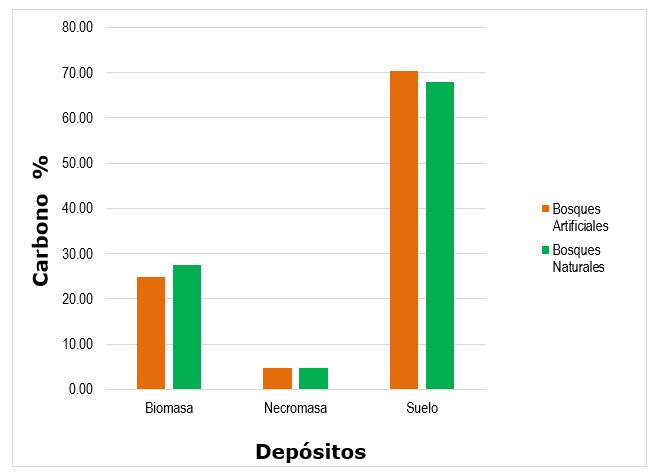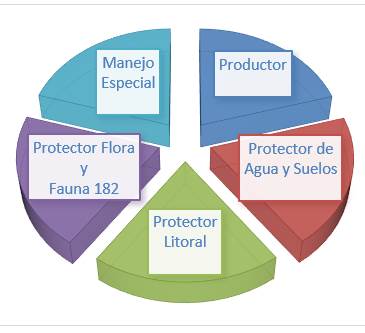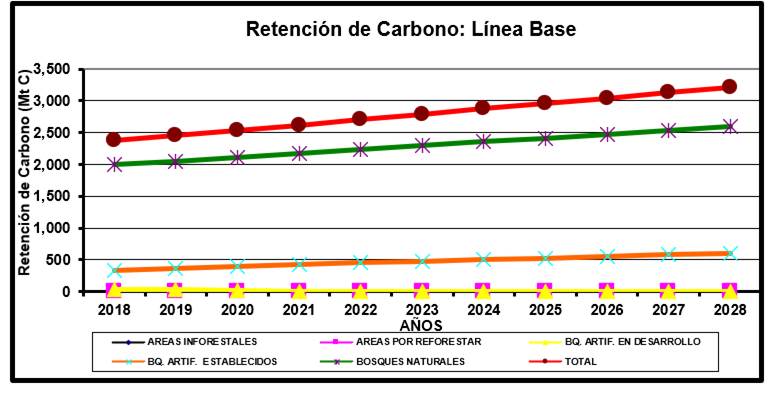Mi SciELO
Servicios Personalizados
Articulo
Indicadores
-
 Citado por SciELO
Citado por SciELO
Links relacionados
-
 Similares en
SciELO
Similares en
SciELO
Compartir
Revista Cubana de Ciencias Forestales
versión On-line ISSN 2310-3469
Rev CFORES vol.11 no.1 Pinar del Río ene.-abr. 2023 Epub 05-Abr-2023
Original article
Carbon retention by forests under xerophytic conditions. Guantanamo, Cuba
1Instituto de Investigaciones Agroforestal, Unidad de Ciencia y Técnica Baracoa. Guantánamo, Cuba.
2Empresa Agroforestal Imías. Guantánamo, Cuba
The research was carried out in areas of natural and artificial forests under xerophytic conditions in the Imías and San Antonio del Sur municipalities of Guantánamo province, with the objective of evaluating carbon retention in these types of forests. The data corresponding to forest dynamics and the Project for the Organization and Development of the Forest Economy of the year 2018 were processed with the automated system SUMFOR v-4.02. Natural forests were the ones with the highest retention with 181.53 tC/ha, while artificial forests retained 179.27 tC/ha. By deposits, the highest percentage is reported in the soil with 68.55 while by forest categories the highest results are obtained by the producing forests with 186.44 tC/ha, the rest of the categories have a similar behavior between them, ranging between 170 and 179. In a projection of the carbon baseline for 10 years, it was evidenced that by the year 2028 total carbon retention would have increased 35% with respect to the initial value, growth to which natural forests would contribute 69%. Information on carbon retention was obtained for the Manigua costera, Uveral, and typical Xerophyte formations that had not yet been studied in the country, and carbon retention values for the species Trichilia hirta L. and Phyllostylon brasiliensis capan. are presented for the first time.
Key words: Carbon sequestration; semi-arid zones; xeric forests.
INTRODUCTION
Forests contribute to the storage of large amounts of atmospheric carbon in plant biomass and in the soil, which is constantly exchanged with the atmosphere through the processes of photosynthesis and respiration, so they play a very important role in preventing the accumulation of carbon dioxide in the atmosphere.
According to FAO (2020), most of the forest carbon is found in living biomass (44 percent) and soil organic matter (45 percent), and the rest in dead wood and litter. The total carbon stock in forests decreased from 668 gigatonnes in 1990 to 662 gigatonnes in 2020; while the carbon density increased slightly during the same period, from 159 to 163 tons per ha.
The carbon report, in the particular case of Cuban forestry activity, is associated with the stock of standing timber in natural and artificial forests (as long as these are under management), information from which the carbon retained by the end of the year. While the calculation of emissions or removals is made by the difference in retentions reported in successive evaluations by the stock difference method (Instituto de Investigaciones Agro-Forestales, 2017).
In this sense, it has been estimated that arid and semi-arid ecosystems cover a third of the continental surface Pointing and Belnap. (2012) and contain 36% of the carbon stored in terrestrial ecosystems Campbell et al., (2008) cited by Montaño et al. (2016). The importance of tropical dry forests lies in the provision of goods and services for society in general. Among them, conserving biodiversity and becoming large global carbon dioxide sinks, constitute an important part of carbon sequestration; according to Luna et al. (2021), these are globally extensive, but little studied.
The Cuban dry forest is made up of a large number of xerophytic trees and shrubs that maintain their foliage all year round and numerous representatives have thorns and thorny-dented leaves. Its greatest development is located in the south of the east. The soil is usually skeletal, especially if it is found in limestone regions where a calcareous structure has developed (Bisse, 1988). The extreme conditions due to low rainfall, poor hydrography and low soil fertility have conditioned the existence of fragile ecosystems with limited productive possibilities.
Considering the scant evidence on the study of the levels of carbon retained in each deposit in xerophytic forests that limits their current management, the objective of this study is to evaluate the potential for carbon retention in forests under xerophytic conditions of the Imías and San Antonio municipalities in the Guantánamo province.
MATERIALS AND METHODS
The forest heritage of the Imías and San Antonio del Sur municipalities covers a total area of 47,226.6 ha, the xerophytic zone has 5,308.3 ha in the Imías municipality and 8,441.9 ha in San Antonio del Sur, this covers a total area of 13,750.2 ha Barbón et al. (2008-2017). It is a territory with coastal and mountainous characteristics that is located to the southeast of the Guantánamo province, having as physical-geographical limits to the north the Yateras and Baracoa municipalities, to the south the Caimanera municipality and the Caribbean Sea, to the east the Maisí municipality and to the west Manuel Tames and Yateras municipalities (Figure 1).
Characterization of the forest heritage of the area under study
As a source of information for artificial and natural forests, the Forest Dynamics corresponding to the year 2018 was used, which includes a general characterization of the forest heritage of the xerophytic zone (Tables 1, Table 2 and Table 3) and for technical management in this area the Forest Economy Organization and Development Project carried out for a period that includes these years 2008-2017 and is in force until the new forest management is carried out (Table 4), both carried out by the Forest Management group (Barbón et al., 2008, 2017).
Table 1. - Composition of the forest heritage of the xerophytic zone of the municipalities of Imías and San Antonio del Sur (ha)
| INDICATOR | 2018 |
|---|---|
| Area of natural forests: | 11,020.0 |
| Area of established artificial forests (ha): | 1 829.8 |
| Area of artificial forests under development (ha): | 295.2 |
| Area to be reforested | 69.4 |
| Bog surface | 10.0 |
| Agricultural land area | 32.4 |
| Area of other forest areas | 493.4 |
| TOTAL | 13,750.2 |
Source: Forest Dynamics 2018.
Table 2. - Characterization of forest heritage for established and developing forests in area (ha), volume (m³) by species in the area under study
| Species scientific names | established artificial forests | artificial forestsDeveloping | |
| Area (ha) | Volume (m³) | Area (ha) | |
| 2.2 | 47.9 | 0.0 | |
| 70.0 | 4 821.0 | 0.0 | |
| 70.0 | 2 646.0 | 0.0 | |
| 35.0 | 1,432.3 | 0.0 | |
| 2.9 | 277.8 | 19.0 | |
| 220.0 | 5 838.0 | 62.0 | |
| 669.7 | 28 127.4 | 90.0 | |
| 1.6 | 46.0 | 0.0 | |
| 39.2 | 1 168.2 | 3.5 | |
| 89.0 | 4 222.9 | 0.0 | |
| 131.5 | 3,086.1 | 3.0 | |
| 13.3 | 356.2 | 32.8 | |
| 82.1 | 4,470.1 | 0.0 | |
| 0.0 | 0.0 | 3.0 | |
| 346.5 | 13,039.7 | 41.9 | |
| TOTAL | 1 773.0 | 69,579.57 | 255.2 |
Table 3. - Characterization of the forest heritage by formations and categories of the study area
| formations | Categories | Area (ha) | Volume (m³) |
|---|---|---|---|
| Mangrove swamp | Protector of the Coast | 72.0 | 1 288.8 |
| coastal jungle | Water and Soil Protector | 51.0 | 1 104.0 |
| Protector of the Coast | 448.0 | 23,654.4 | |
| Flora and Fauna Protector | 356.0 | 18,796.8 | |
| Special Handling | 326.0 | 11,752.3 | |
| Uveral | Protector of the Coast | 69.0 | 1 573.2 |
| Flora and Fauna Protector | 37.0 | 843.6 | |
| typical xerophyte | Producer | 5,749.7 | 291 774.2 |
| Water and Soil Protector | 2 376.0 | 101 692.8 | |
| Protector of the Coast | 663.5 | 28,397.8 | |
| Flora and Fauna Protector | 297.1 | 8 771.0 | |
| Special Handling | 574.7 | 735.0 | |
| TOTAL | 11,020.0 | 510 368.36 | |
The data corresponding to the valued year were processed using version 4.02 of the SUMFOR automated system (Álvarez, Mercadet and Peña, 2019), which takes into account the carbon retained in all deposits (aerial and underground biomass, necromass and soil) and in all the components (natural forests, plantations, plantations under development, area to be covered and unforested area).
Table 4 Characterization of technical management in the forest heritage of the study area
| Indicator | 2018 |
|---|---|
| Average survival of artificial forests (%): | 75 |
| Average achievement of reforestation (%) | fifty |
| Annual volume extracted by other fellings (m 3 ) | 2 096.0 750.00 |
| Current annual increase of natural forests (m³/ha/year) | 1.40 |
| Average annual increase in artificial forests (m³/ha/year) | 2.90 |
RESULTS AND DISCUSSION
Carbon retention in the xerophytic zone forest heritage of the Imías and San Antonio del Sur municipalities
The total retention achieved by the forest heritage of both municipalities only exceeded, among 13 areas of the country, those reported in Ciego de Ávila INAF (2019), while the highest retentions are reached in natural forests (181.53 tC / ha) these exceed man-made forests by more than 10 %. Ledesma et al. (2020) in studies carried out in areas of native semi-xerophytic forests of Espinal (Entre Ríos), Argentina, determined carbon retentions of 263.88 tC/ha higher than those determined in the Forest Heritage of Imías and San Antonio del Sur municipalities. These authors highlight the role of native or natural forests in the global carbon (C) cycle, given their role as CO 2 sequesterer, regulating the gas exchange between plant biomass, soil and atmosphere.
The artificial forests (plantations) of this xerophytic zone present a carbon retention (179.27 tC/ha) higher than those achieved in works carried out by the Agroforestry Group (GAF) in Las Tunas in similar areas in the years 2016 and 2018 with values of 165.21 and 164.63 tC/ha respectively, while it was lower than those of 11 other areas of the country, also in works carried out by the Agroforestry group for both years (INAF 2017- INAF (2019).
Carbon sequestration by species
The carbon sequestrations registered in the artificial forests established by species (>3 years old) in the study area (Table 5), Cocos nucifera reaches the highest values with 210.72 tC/ha followed by Colubrina ferruginosa 204.10 and Rizhophora mangle 201.69. Thesethree species retain more than 190 tC/ha, surpassing Lysiloma latisiliqua with the lowest value by more than 50 tC/ha. Luna et al., (2021) point out that in the Arenillas Ecological Reserve located to the south of the Ecuadorian coast, the species Ceiba trichistandra and Eriotheca ruizii reached the highest values in carbon retention with more than 249.79 tC/ha, higher than the obtained in the present investigation.
In relation to the national average retentions reported by the Agroforestry Group, the xerophytic zone of the Imías and San Antonio del Sur municipalities. The carbon retention values obtained for Trichilia hirta with 167.78 tC/ha and Phyllostylon brasiliensis 169.07 tC/ha, provide information by incorporating it into existing databases, since they have not been quantified in other areas of the Forest Heritage of the country.
Table 5 - Carbon sequestration by species
| SPECIES | Surface (ha) | Carbon sequestration (tC/ha) |
| 2.2 | 156.40 | |
| 70.0 | 204.10 | |
| 70.0 | 167.78 | |
| 35.0 | 186.90 | |
| 2.9 | 210.72 | |
| 220.0 | 178.08 | |
| 726.5 | 175.45 | |
| 1.6 | 169.07 | |
| 39.2 | 201.69 | |
| 89.0 | 180.79 | |
| 131.5 | 150.50 | |
| 13.3 | 162.95 | |
| 82.1 | 187.49 | |
| 346.5 | 178.95 |
The species Conocarpus erectus is not included in the table because there are no established plantations in the study area
Carbon sequestration by plant formations
Another relevant aspect is that the natural forests in the area under study are made up of three formations (Coastal Manigua, Uveral and typical Xerophilous). In the case of the typical Xerophyte, it is collected for the first time in the Carbon Report of the GAF Agroforestry Group (2018) of the Ministry of Agriculture and INAF (2019), and in these areas it is the only one of the three that presents areas categorized as producers. It also has the highest carbon retention values with 182.34 (tC/ha) (Figure 2), it is also the one that occupies the largest area with 9 661.0 ha of forests. Mangrove formation follows with values of 180.33 (tC/ha), in this regard, Salazar (2018) refers that mangroves can accumulate up to five times more carbon than terrestrial forests and thanks to this their important role in climate change mitigation.
Carbon sequestered by pools (%) in natural forests and plantations
The distribution by deposit of carbon sequestered in the southern forests of these municipalities (Figure 3) indicated that, as usual, the soil is where more organic carbon accumulates. That coincides with studies carried out by Retana et al., (2019) to estimate the biomass and carbon stored in the different components of the forest, of three sites belonging to the "El Rodeo" protective zone, located west of San José, Costa Rica where the soil stored 50.79 % of the total carbon. However, it differs in the results achieved in biomass in these xerophytic conditions of the study area, which carbon values of 27 % of the total are obtained, the author also highlights, that the biomass concentrated 46.35 % of the total carbon in the intervened primary forests.
In the soils occupied by artificial forests (plantations) under xerophytic conditions in the study area, carbon values exceed those of natural forests, which is conditioned by the existence of plantations of the Leucaena leucocephala species that occupies 41 % of the area between other deciduous and soil-forming species. This result coincides with what was stated by (Cascante and Estrada, 2001) cited by Retana et al., (2019) when they refer that their results could be associated with the fact that the site has a species diversity similar to that of dry forests, which allowed a greater accumulation of leaves on the ground, due to the deciduous characteristics of some of them.
Briones, (2017) obtained similar results in relation to the soil, this being the main carbon store in one of his studies, representing between 45% and 90% of the carbon in the biomass. Therefore, the author refers that the Mexican arid zones can function as carbon sinks or exporters and dumps, in this regard Pérez et al. (2021) in their study showed that the content of Soil Organic Carbon (SOC) corresponding to forests was higher in relation to the different ecosystems studied.
In the biomass and necromass of the forests of the xerophytic zone of the San Antonio del Sur and Imías municipalities, it reached 26.31 and 27.48 % carbon respectively in plantations and natural forests, while the % in the necromass of both were the same of lower value with 4.31 and 4.75 (%). In a study carried out by Retana et al., (2019) in a primary forest intervened in the "El Rodeo" protective zone, Costa Rica, determined that Herbaceous vegetation, leaf litter and necromass were the components that stored the least amount of carbon within the ecosystem, coinciding with the results obtained in this investigation.
Carbon sequestrations by forest category
Regarding the five forest categories present in the study area (Figure 4), the maximum difference between the one with the highest and lowest yield barely exceeds 3.9 tC/ha, with the producing forests being those with the highest retentions with 186, 44, followed by special handling with 184.73, in this same order they follow Protector Flora/Fauna with 182.02, protector of the Coast with 179.02 and Protector of Water and Soils with 177.68.
Projection of carbon sequestration in the medium term (10 years)
Assuming that the area and composition of the forest heritage in this area remain constant over time and that the management applied to it during all that time is the same as that reported for 2018 (Table 6).
Figure 5 shows how the carbon baseline would behave, evidencing that in the year 2028 the total carbon sequestration would have increased 35% with respect to the initial value, growth to which natural forests would contribute 69 %.
The carbon baseline calculated for the forest estate evaluated in this area presents a type 1 pattern, in which the temporal relationship of change in carbon sequestered in established natural and artificial forests is characterized by ascending and approximately parallel lines, such as was reported for the Agroforestry Companies of Pinar del Río, South Coast, Mayabeque and Sancti Spiritus at the end of 2018 (INAF 2019).
Table 6. - Results of the carbon sequestration baseline (ktC)
| VARIABLES | YEARS | ||||||||||
| 2018 | 2019 | 2020 | 2021 | 2022 | 2023 | 2024 | 2025 | 2026 | 2027 | 2028 | |
| Forest Areas | 9.52 | 9.52 | 9.52 | 9.52 | 9.52 | 9.52 | 9.52 | 9.52 | 9.52 | 9.52 | 9.52 |
| Areas to Reforest | 4.81 | 5.63 | 5.94 | 5.74 | 5.02 | 4.31 | 3.59 | 2.88 | 2.16 | 1.45 | 0.73 |
| Developing Artificial Forests | 33.84 | 26.14 | 18.44 | 10.74 | 10.74 | 10.74 | 10.74 | 10.74 | 10.74 | 10.74 | 8.99 |
| Established Artificial Forests | 311.90 | 342.99 | 375.18 | 408.47 | 436.26 | 464.39 | 492.88 | 521.72 | 550.91 | 580.44 | 610.34 |
| Natural Forests | 2,000.43 | 2,052.69 | 2 112.92 | 2 173.15 | 2,233.38 | 2,293.61 | 2,353.84 | 2,414.07 | 2,474.30 | 2,534.53 | 2,594.76 |
| TOTAL | 2 360.50 | 2,436.96 | 2,521.99 | 2,607.62 | 2,694.92 | 2,782.57 | 2 870.57 | 2,958.92 | 3,047.62 | 3 136.68 | 3 224.33 |
CONCLUSIONS
In the forest heritage of the xerophytic zone of the San Antonio del Sur and Imías municipalities, natural forests are the ones with the highest carbon retention.
The information obtained on carbon retention can be used to establish the management of natural forests (Coastal Manigua, Uveral and typical Xerophilous) to contribute to climate change mitigation.
Data on carbon retention in the species Trichilia hirta and Phyllostylon brasiliensis are obtained, which allow updating the database.
REFERENCIAS BIBLIOGRÁFICAS
ÁLVAREZ, A., MERCADET, A. y PEÑA, Y., 2019. Elaboración y puesta a punto de la v-4.00 del sistema automatizado SUMFOR. Inf. Técn. Proy. Contribución del Sector Forestal Cubano a la Tercera Comunicación Nacional. La Habana, Cuba: Inst. Inv. Agro-Forestales. [ Links ]
BARBÓN, M.I., FERRER, E., CARDOSA, O. y MOREIRA, W., 2008. Proyecto de Organización y Desarrollo de la Economía Forestal para la Empresa Agroforestal Imías 2008-2017. S.l.: Ministerio de la Agricultura. Grupo Agroforestal. [ Links ]
BISSE, J., 1988. Arboles de Cuba [en línea]. S.l.: Editorial Científico-Técnica. Disponible en: https://books.google.com.cu/books/about/Arboles_de_Cuba.html?id=R9olAQAAMAAJ&redir_esc=y. [ Links ]
BRIONES, O., 2017. El ciclo del carbono en las zonas áridas mexicanas. Instituto de Ecología, A.C. [en línea], pp. 1-3. [Consulta: 10/03/2023]. Disponible en: Disponible en: https://inecol.mx/inecol/index.php/es/2013-06-05-10-34-10/17-ciencia-hoy/850-el-ciclo-del-carbono-en-las-zonas-aridas-mexicanas . [ Links ]
FAO, 2020. Evaluación de los recursos forestales mundiales 2020. Principales resultados. [en línea]. Roma, Italia: FAO. Disponible en: https://www.fao.org/forest-resources-assessment/2020/es. [ Links ]
INSTITUTO DE INVESTIGACIONES AGRO-FORESTALES (INAF), 2017. Reporte de Carbono del GAF 2017. La Habana, Cuba: INAF. [ Links ]
INSTITUTO DE INVESTIGACIONES AGRO-FORESTALES (INAF), 2019. Reporte de Carbono del GAF 2018. La Habana, Cuba: INAF . [ Links ]
LEDESMA, S.G., SIONE, M.S., OSZUST, J.D. y ROSENBERGER, L.J., 2021. ESTIMACIÓN DEL CONTENIDO Y CAPTURA POTENCIAL DE CARBONO EN LA BIOMASA ARBÓREA DE BOSQUES NATIVOS DEL ESPINAL (Entre Ríos, Argentina). FAVE: Sección Ciencias Agrarias [en línea], vol. 20, no. 1, pp. 331-345. [Consulta: 10/03/2023]. ISSN 2346-9129, 1666-7719. Disponible en: Disponible en: https://dialnet.unirioja.es/servlet/articulo?codigo=8025592 . [ Links ]
MONTAÑO, N.M., AYALA, F., BULLOCK, S.H., BRIONES, O., GARCÍA OLIVA, F., GARCÍA SÁNCHEZ, R., MAYA, Y., PERRONI, Y., SIEBE, C., TAPIA TORRES, Y., TROYO, E. y YÉPEZ, E., 2016. Almacenes y flujos de carbono en ecosistemas áridos y semiáridos de México: Síntesis y perspectivas. Terra Latinoamericana [en línea], vol. 34, no. 1, pp. 39-59. [Consulta: 10/03/2023]. ISSN 0187-5779. Disponible en: Disponible en: http://www.scielo.org.mx/scielo.php?script=sci_abstract&pid=S0187-57792016000100039&lng=es&nrm=iso&tlng=es . [ Links ]
RETANA-CHINCHILLA, L., MÉNDEZ-CARTÍN, A.L., SÁNCHEZ-TORUÑO, H., MONTERO-FLORES, W., BARQUERO-ELIZONDO, A.I., HERNÁNDEZ-SÁNCHEZ, L.G., 2019. Estimación de la biomasa y carbono almacenado en un bosque primario intervenido de la zona protectora"El Rodeo", Costa Rica. Revista Cubana de Ciencias Forestales [en línea], vol. 7, no. 3, pp. 341-353. [Consulta: 10/03/2023]. ISSN 2310-3469. Disponible en: Disponible en: http://scielo.sld.cu/scielo.php?script=sci_abstract&pid=S2310-34692019000300341&lng=es&nrm=iso&tlng=es . [ Links ]
SALAZAR, K., 2018. Estudio permite determinar con mayor precisión captura de carbono en manglares para mejorar estrategias de mitigación para LatinClima pp1 [en línea]. 2018. S.l.: CATIE. Disponible en: https://latinclima.org/articulos/estudio-permite-determinar-con-mayor -precision-captura-de-carbono-en-manglares-para. [ Links ]
Received: February 28, 2023; Accepted: April 03, 2023











 texto en
texto en 

